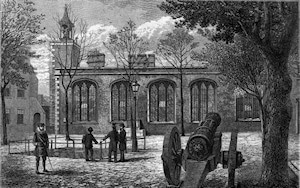
I decided to write this article because there is so much false information out there about the restoration work at St Peter ad Vincula Chapel in the 19th century, the exhumation of Anne Boleyn and various other Tudor remains, and Anne Boleyn’s resting place.
I recently purchased a copy of the 1877 “Notices of the Historic Persons Buried in the Chapel of St Peter ad Vincula in the Tower of London, With an Account of the Discovery of the Supposed Remains of Anne Boleyn” by Doyne C Bell (Secretary to Her Majesty’s Privy Purse), which is a full record of the restorations in 1876 and 1877, including the findings of Dr Frederick J Mouat (professor of medicine) who examined the remains found, so I can tell you exactly what was found in the 19th century and what was done with it.
The Restorations
In his “History of England”, Lord Macaulay said of St Peter ad Vincula:-
“I cannot refrain from expressing my disgust at the barbarous stupidity which has transformed this interesting little church into the likeness of a meeting house in a manufacturing town. In truth there is no sadder spot on earth than this little cemetery. Death is there associated not, as in Westminster and St Paul’s, with genius and virtue, with public veneration and with imperishable renown; not as in our humblest churches and churchyards, with everything that is most endearing in social and domestic charities: but with what ever is darkest in human nature and in human destiny; with the savage triumph of implacable enemies, with the inconstancy, the ingratitude, the cowardice of friends, with all the miseries of fallen greatness and of blighted fame.
“Thither have been carried through successive ages, by the rude hands of gaolers, without one mourner following, the bleeding relics of men, who had been captains of armies, the leaders of parties, the oracles of senates, and the ornaments of courts.”1
And it was the unsightly state of the chapel, along with the need to do repairs for sanitary reasons, which led to Sir Charles Yorke, Constable of the Tower, to submit plans for restoration to Queen Victoria in 1876. The resulting decision was that “the chapel should be, as far as possible, architecturally restored to its original condition, and also suitably arranged as a place of worship for the use of the residents and garrison of the Tower.”2
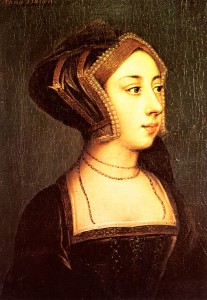
The proposed restoration work included relaying the pavement, which had sunk over the years, and to install some kind of heating. It was when the pews were removed and the pavement stones lifted in August 1876, that “the resting places of those who had been buried within the walls of the chapel… had been repeatedly and it was feared almost universally desecrated.”3 Due to the fact that the ground needed to be cleared so that proper foundations could be laid for the pavement, it was necessary to remove the remains to the crypt, unless they were in stable vaults. The remains were therefore “carefully collected and enclosed in boxes, with suitable inscriptions; and all the coffins which were found intact were at once removed to the crypt.”4
The Restoration of the Chancel
In October 1876 the issue of the chancel came to the forefront. As records showed that the Tudor queens Anne Boleyn and Catherine Howard were buried there, along with the Dukes of Somerset, Northumberland and Monmouth, it had been decided to leave the chancel undisturbed and to just lay the new pavement over the top of the old. However, the Surveyor examined the area and found that the pavement had sunk in two places and there was no other option but to remove it and to replace it with tiles or symmetrical paving so that it would be within keeping with the rest of the chapel.
Doyne C Bell had used historical sources to create a plan of the resting places of the queens and dukes and it was decided that any remains found should be re-interred on the same spot and labelled (see the plan towards the bottom of the page).
The remains of Anne Boleyn
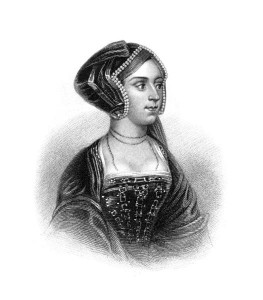
When the pavement was lifted in the area thought to have been the resting place of Anne Boleyn, the bones of a female were found at a depth of about two feet, “not lying in the original order, but which had evidently for some reason or other been heaped together into a smaller space.”5. The bones were then examined by Dr Mouat who confirmed that they belonged to “a female of between twenty-five and thirty years of age, of a delicate frame of body, and who had been of slender and perfect proportions; the forehead and lower jaw were small and especially well formed. The vertebrae were particularly small, especially one joint (the atlas), which was that next to the skull, and they bore witness to the Queen’s ‘lyttel neck’.”6 Although the bones were mixed up, there were no further female remains at that spot. The bones of George Boleyn were not found but it was thought that the ground had been disturbed in the late 18th century and his remains removed then, or that he was buried further towards the north wall, in an area not touched by the restoration work.
Dr Mouat’s Findings
Of the remains of Anne Boleyn, Dr Mouat wrote in a memorandum:-
“The bones found in the place where Queen Anne Boleyn is said to have been buried are certainly those of a female in the prime of life, all perfectly consolidated and symmetrical, and belong to the same person.
“The bones of the head indicate a well-formed round skull, with an intellectual forehead, straight orbital ridge, large eyes, oval face and rather square full chin. The remains of the vertebrae, and the bones of the lower limbs, indicate a well-formed woman of middle height, with a short and slender neck. The ribs show depth and roundness of chest. The hands and feet bones indicate delicate and well-shaped hands and feet, with tapering fingers and a narrow foot.”7
He went on to say that they were consistent with descriptions of Anne and the sitter of the Holbein painting owned by the Earl of Warwick.
Dr Mouat also wrote a detailed report of his examination of the skeleton, in which he noted that Anne was about 5′ – 5’3 inches in height. A careful examination of the finger bones did not show any evidence of a sixth finger or any type of malformation.
Other Remains
Some male bones were found close to the remains of Anne Boleyn and these were examined and found to have belonged to a tall man of around the age of 50. It was thought that they belonged to Protector Somerset (Edward Seymour) who was recorded as being laid in to rest between Anne Boleyn and Catherine Howard in 1551, along with John Dudley, Duke of Northumberland, who was executed in 1553. The bones of another man of about 50 years of age were then found and these were identified as the Duke of Northumberland.
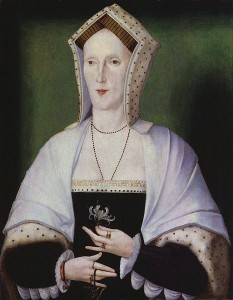
Nearer to the wall of the chancel, in a south-east direction, the bones of two females were found, the first set belonging to a female of 30-40 years of age and the other of an elderly female. The team identified these as belonging to Lady Rochford and Margaret Pole, Countess of Salisbury.
Beneath a stone bearing the name of Sir Allan Apsley, Lieutenant of the Tower, who died in 1630, the bones of a man were found, and then the leg bones of a tall man, identified as the Duke of Monmouth, were found in the expected place, as recorded “under the communion table”. Another large skeleton was found under the Duke of Monmouth’s remains, but these could not be identified.
The remains of Catherine Howard were not found and it was thought that this was due to her youth (young bones are softer and more cartilaginous and so disintegrate more rapidly) and the use of lime in her interment – lime was found in the place thought to have been her grave.
The Duke of Northumberland’s Remains
Dr Mouat recorded that “these bones evidently belonged to a large man, about six feet in height; and aged about 50 years.”8
Margaret Pole’s Remains
Dr Mouat recorded that these bones belonged to “a tall and aged female”9.
Lady Rochford’s Remains
The only notes that were made regarding the remains of Jane Boleyn, Lady Rochford, were that they belonged to a woman of around 40 and were found where expected, next to the supposed grave of Catherine Howard. Lady Rochford was executed on the same day as Catherine.
What Happened to the Remains?
The records of the meeting held on the 13th April 1877 in the Chapel of St Peter ad Vincula, made by Bell, tell us that the remains of the seven people found in the chancel in November 1876 were:-
“soldered up in thick leaden coffers, and then fastened down with copper screws in boxes made of oak plank, one inch in thickness. Each box bore a leaden escutcheon, on which was engraved the name of the person whose supposed remains were thus enclosed, together with the dates of death, and of the year (1877) of the reinterment.
“They were then placed in the respective positions in the chancel in which the remains had been found, and the ground having been opened, they were all buried about four inches below the surface, the earth was then filled in, and concrete immediately spread over them.”10
They were put back in the positions recorded by Bell and were buried with respect.
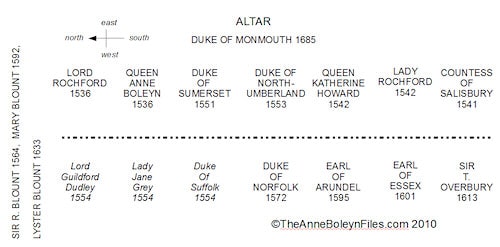
A memorial tablet of those buried in the chapel was also produced and placed on the wall near the entrance door, where it can still be seem today. It reads:-
List of Remarkable Persons Buried in this Chapel
- Gerald Fitzgerald, Earl of Kildare 1534
- John Fisher, Bishop of Rochester 1535
- Sir Thomas More 1535
- George Boleyn, Viscount Rochford 1536
- Queen Anne Boleyn 1536
- Thomas Cromwell, Earl of Essex 1540
- Margaret of Clarence, Countess of Salisbury 1541
- Queen Katharine Howard 1542
- Jane, Viscountess Rochford 1542
- Thomas, Lord Seymour of Sudeley 1549
- Edward Seymour, Duke of Somerset 1551
- Sir Ralph Vane 1552
- Sir Thomas Arundell 1552
- John Dudley, Duke of Northumberland 1553
- Lord Guildford Dudley 1554
- Lady Jane Grey 1554
- Henry Grey, Duke of Suffolk 1554
- Thomas Howard, Duke of Norfolk 1572
- Sir John Perrott 1592
- Philip, Earl of Arundel 1595
- Robert Devereux, Earl of Essex 1601
- Sir Thomas Overbury 1613
- Thomas, Lord Grey of Wilton 1614
- Sir John Eliot 1632
- William, Viscount Stafford 1680
- Arthur, Earl of Essex 1683
- James, Duke of Monmouth 1685
- George, Lord Jeffreys 1689
- John Rotier 1703
- Edward, Lord Griffin 1710
- William, Marquis of Tullibardine 1746
- William, Earl of Kilmarnock 1746
- Arthur, Lord Balmerino 1746
- Simon, Lord Fraser of Lovat 1747
Bell’s book then goes on to give an account of the arrest, imprisonment, death and burial of each person on this list.
The Scaffold Memorial
In 1866, Queen Victoria commanded that the spot where it was thought that Queen Anne Boleyn and others had been executed should be cordoned off by a railing and a memorial plaque placed there. A brass plate on a stone was inscribed with the following words:-
“Site of the ancient scaffold: on this spot Queen Anne Boleyn was beheaded on the 19th May, 1536.”
Today we have the modern glass memorial which was unveiled in 2006. It was designed by Brian Catling and features two engraved circles with a glass-sculpted pillow at the centre and words etched around the outside of the circle:-
“Gentle visitor pause a while,
Where you stand death cut away death cut away the light of many days.
Here, jeweled names were broken from the vivid thread of life.
May they rest in peace while we walk the generations around their strife and courage,
Under these restless skies.”
Anne Boleyn’s Body?
But did the bones that the Victorians find really belong to Anne Boleyn? I’ll discuss this in my next article “Anne Boleyn’s Body Found?“.
Notes and Sources
- Macaulay’s History of England, Vol. I, pp 628-9, quoted in Notices of the Historic Persons Buried in the Chapel of St Peter ad Vincula in the Tower of London, With an Account of the Discovery of the Supposed Remains of Anne Boleyn” by Doyne C Bell 1877, p8-9
- Bell, p10
- Ibid., p15
- Ibid., p16
- Ibid., p20
- Ibid., p21
- Ibid., p26
- Ibid., p29
- Ibid.
- Ibid., p30